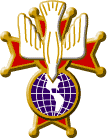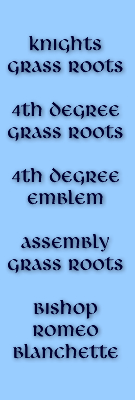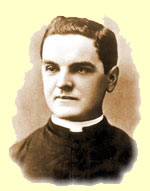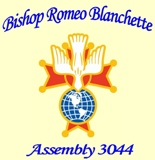


 On Oct. 2, 1881, a small group of men met in the basement
of St. Mary's Church on Hillhouse Avenue in New Haven, Connecticut.
Called together by their 29-year-old parish priest,
Father Michael J. McGivney, these men formed a fraternal society
that would one day become the world's largest Catholic family
fraternal service organization. They sought strength in solidarity,
and security through unity of purpose and devotion to a holy cause:
they vowed to be defenders of their country, their families and
their faith. These men were bound together by the ideal of
Christopher Columbus, the discoverer of the Americas, the one
whose hand brought Christianity to the New World. Their efforts
came to fruition with the incorporation of the Knights of
Columbus on March 29, 1882. They were Knights of Columbus.
On Oct. 2, 1881, a small group of men met in the basement
of St. Mary's Church on Hillhouse Avenue in New Haven, Connecticut.
Called together by their 29-year-old parish priest,
Father Michael J. McGivney, these men formed a fraternal society
that would one day become the world's largest Catholic family
fraternal service organization. They sought strength in solidarity,
and security through unity of purpose and devotion to a holy cause:
they vowed to be defenders of their country, their families and
their faith. These men were bound together by the ideal of
Christopher Columbus, the discoverer of the Americas, the one
whose hand brought Christianity to the New World. Their efforts
came to fruition with the incorporation of the Knights of
Columbus on March 29, 1882. They were Knights of Columbus.
The Order has been called "the strong right arm of the Church," and has been praised by popes, presidents and other world leaders, for support of the Church, programs of evangelization and Catholic education, civic involvement and aid to those in need.
Father McGivney's founding vision for the Order also included a life insurance program to provide for the widows and orphans of deceased members. The Order's insurance program has expanded substantially to serve more effectively the Knights' growing membership. Year after year, the Knights of Columbus has earned the highest possible quality ratings for financial soundness from A.M. Best and Standard & Poor's. The Order provides the highest quality insurance, annuity and long-term care products to its members, along with many other fraternal benefits.
The Supreme Council is the governing body of the Knights of Columbus and is responsible for the development of the organization as a whole. Supreme Council duties include establishing the Order in new regions and setting up regional authorities, defining and advancing its values and goals, undertaking organization-wide initiatives, promoting awareness of the Knights' mission worldwide, and protecting the families of members through its extensive insurance program. Members working in local, or subordinate councils, however, carry on the majority of the Knights' beneficial work.
![]()
The history of the creation of the Fourth Degree of the
Knights of Columbus of is directly linked to the social
and political climate in the United States at the turn
of the last century. It is in that light that the
connection between the Fourth Degree and its Color Corps,
that has grown to be the most visible aspect of the Knights,
must be seen.
The idea of adding new degrees to the Order's original three, (Charity, Unity, Fraternity) first came to light in 1886. Supreme Knight James T. Mullen appointed a committee to look into forming two new "commander" degrees. That same year the Connecticut Catholic, a local newspaper, carried an advertisement calling members of local Knights of Columbus councils to meet to form a "Uniformed Legion." The idea for this new unit arose from a growing nation wide sense of Nationalism, or what we would call today Patriotism. The unknown author in Connecticut was not alone in wanting a visible organization.
At this time, very little happened because there was not enough wide spread interest in creating additional new degrees. The Order's leaders balked at the idea of a Uniformed Legion for the simple reason that the cost for the "Uniform" was well over $100.00. They feared the "Legion" would cause an economical class split between wealthy and poorer members of the Order.
Following the Spanish American War, it was decided that there should be one new Degree added based on the principle of Patriotism. In 1899, Edward L. Hearn was elected Supreme Knight and he immediately appointed a committee to establish and format the new Degree to be given the following year.
In order to qualify for this Degree each candidate had to be a Third Degree member of the Knights of Columbus in good standing for three years, and show evidence of distinctive service to the Order, church, and community. Finally the candidate had to have a letter from his priest stipulating that he had received communion within the past two weeks.
The first Exemplification of the new Degree was scheduled to be held in the Astor Hotel in New York City on February 22, 1900. However, there were so many candidates, the Exemplification had to be moved to a larger venue. Therefore the site was moved to the Lenox Lyceum. At this first Exemplification of the Fourth Degree 1,100 members of the Knights of Columbus, being in good standing "took their fourth." The second Exemplification, held in Boston on May 8, 1900 saw another 750 Third Degree knights join the ranks of Sir Knights.
In the early years of the Fourth Degree, members met as part of their councils, mostly after meetings. In 1910, during a reorganization of the Order's leadership, the first Assemblies were created. Additionally the position of Supreme Master was established to lead the Fourth Degree internationally. Vice Supreme Masters lead Provinces and Masters head Districts. This system has spread and flourished as Sir Knights not only serve their local Church through their service to local councils but also their joint efforts in these Assemblies.
The Honor Guard, first called for in 1886 was officially formed in 1902, for ceremonial purposes. Since that time, the uniforms of the Color Corps have varied, however all have shared the similar theme of mariners. Most noticeable in today's current uniform is the chapeau worn with ostrich feathers.
![]()

The Triad Emblem of the Fourth Degree of the Knights of Columbus features:
- The Dove
- The Cross
- The Globe
Our Honored Order cherishes as its patron Christopher Columbus. Christopher...Christ Bearer Columbus...Dove of Peace, symbolizing the Paraclete.
Spiritually, the sacred symbols on the emblem typify the Union of the Three Divine Persons in one God...the most blessed Trinity.
- The Globe... God the Father, Creator of the Universe
- The Cross...God the Son, Redeemer of Mankind
- The Dove...God the Holy Spirit, Sanctifier of humanity
The colors of the symbols are:
- A Blue Globe with the lands of the Western Hemisphere in White
- A Red Cross with Gold borders, and Gold knobs at the ends of the Cross
- A White Dove.
Red, White, and Blue are the colors of the flag of the country in which our Order originated; and are used to stress the basic principle of the Fourth Degree.

![]()
On May 3, 2007, there was an assembly formation meeting held
at St. Raphael's Church in Naperville. At this meeting an
election of officers was held along with the selection of
the name of our new assembly. We selected Bishop Romeo Blanchette
as our namesake. Bishop Romeo Blanchette was the second bishop
of the Joliet Diocese. Our next subsequent meeting was the installation
of officers which was held on June 2, 2007 at St. Raphael's Church in
Naperville. Since our installation, the assembly has been working on
developing activities in promoting patriotism and the 4th degree of our order.
A short biography on Bishop Romeo Blanchette follows below.
On April 9, 2008 our assembly voted on our by-laws. You can review the current by-laws by clicking on the icon below.
To read the current by-laws, you will need a copy of Adobe Acrobat Reader which can be obtained here:
![]() Click On Get Acrobat Reader To Download Adobe Acrobat
Click On Get Acrobat Reader To Download Adobe Acrobat


Click on the booklet which will allow you to
view the current laws and rules of our assembly.
(A PDF reader similar to Adobe Acrobat is required)
![]()
 Bishop Romeo Blanchette was born in St. George, Kankakee County,
Illinois, on January 6, 1913. As a young man, he had aspirations
of becoming a priest. In 1928, he enrolled in the
Archbishop Quigley Preparatory Seminary, Chicago, Illinois,
and graduated in 1931. Bishop Blanchette was ordained a
priest in 1937 in Chicago, Illinois. Father Blanchette obtained
Bachelor degrees in Sacred Theology and Cannon Law, as well as a
Master’s degree in Theology.
Bishop Romeo Blanchette was born in St. George, Kankakee County,
Illinois, on January 6, 1913. As a young man, he had aspirations
of becoming a priest. In 1928, he enrolled in the
Archbishop Quigley Preparatory Seminary, Chicago, Illinois,
and graduated in 1931. Bishop Blanchette was ordained a
priest in 1937 in Chicago, Illinois. Father Blanchette obtained
Bachelor degrees in Sacred Theology and Cannon Law, as well as a
Master’s degree in Theology.
In 1948, Pope Pius XII established the Joliet Diocese, which was canonically erected on March 24, 1949. Fr. Blanchette was assigned to establish a chancery office for the newly created Joliet Diocese in 1949. He was appointed Vicar General of the Joliet Diocese on January 6, 1950 and was invested as a domestic prelate with the title of Right Reverend Monsignor on August 1, 1950. On April 3, 1965, he was consecrated Auxiliary Bishop of the Joliet Diocese.
Most Reverend Blanchette was appointed the second Bishop of the Joliet Diocese by Pope Paul VI on July 19, 1966, was consecrated on August 31, 1966, and served in this capacity until January 30, 1979 when he resigned after being diagnosed with Lou Gehrig’s Disease. He succumbed to the illness and died on January 1, 1982.
During his tenures as Vicar General, Chancellor, Auxiliary Bishop and Bishop of this new and growing Diocese, he continually participated with and invoked the services of the Knights of Columbus. Bishop Blanchette was himself a Knight and knew what a great source of assistance the Knights could be in the support of the new Diocese. The Joliet Diocese grew from 90,000 parishioners to over 400,000 parishioners while he was Bishop, and he continually relied on the Knights of Columbus to help serve this ever expanding Diocese.
Sir Knight Bishop Blanchette was instrumental in seeking out and appointing Chaplains for the numerous Councils being chartered in this rapid diocese growth period. He was known to regularly attend Knights’ functions all throughout the seven counties of the Diocese. He enlisted the Knights to help raise funds for the Bishop’s Burse to support Seminarians because he knew the Knights would be instrumental in promoting and assisting vocations. Bishop Blanchette also regularly invited the Knights’ Honor Guard to participate in numerous diocese ceremonies, including church dedications and confirmations; in order to perpetuate the visible presence of the Knights, and the important work they do.
Bishop Blanchette was not only a member of the Knights of Columbus, he was a fourth degree Knight; he was an active participant and promoter of the Knights work. Bishop Blanchette thought so highly of the Knights in the infant stages of the Joliet Diocese, it seems only fitting that a new, charter assembly in his own Diocese be named after him.
Send comments or questions to the web page editor, Webmaster